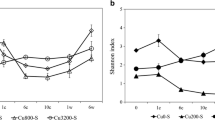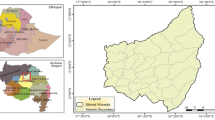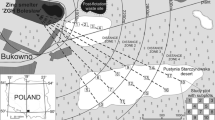Abstract
In order to evaluate the power of laboratory toxicity tests to predict the situation in the field, soil microarthropods were studied at the population and community levels in a copper contaminated field, and data were compared to the outcome of single species laboratory tests in the same soil type from a companion study. In addition to copper, the influence of several soil characteristics and plant cover data on soil microarthropod abundance and distribution was tested. Total microarthropod abundance was highest at intermediate copper concentrations, and linearly related to grass biomass. For single species populations no clear picture of abundance in relation to soil copper was seen. Two collembolan species, Folsomia quadrioculata and Folsomia fimetaria, were among the most sensitive. The Shannon-Wiener index of biodiversity decreased linearly with increasing soil copper concentrations. The application of multivariate statistics showed copper to be the parameter best fitting the distribution of microarthropod species in the field. A distinction could be made between sampling points with 50–199 mg Cu/kg soil and those with higher copper concentrations. The species composition of the microarthropod community was not correlated with plant species diversity or total grass biomass, but was affected by a nearby row of tall trees. Community analysis of field data proved as sensitive as laboratory testing, and seemed superior to single species field population data concerning detection of copper effects on soil microarthropods.
Similar content being viewed by others
References
Attrill, M.J. and Depledge, M.H. (1997). Community and population indicators of ecosystem health: targeting links between levels of biological organisation. Aquatic Toxicology 38, 183–97.
Attrill, M.J., Rundle, S.D. and Thomas, R.M. (1996). The influence of drought-induced low freshwater flow on an upper-estuarine macroinvertebrate community. Water Research 30, 261–8.
Axelsen, J.A., Holst, N., Hamers, T. and Krogh, P.H. (1997). Simulations of the predator-prey interactions in a two species ecotoxicological test system. Ecological Modelling 101, 15–25.
Axelsen, J.A., Holmstrup, M. and Krogh, P.H. (1998). Simulation of development and reproduction of Collembola sampled from synchronized cultures. Pedobiologia 42, 1–9.
Bengtsson, G. and Rundgren, S. (1988). The Gusum case: A brass mill and the distribution of soil Collembola. Canadian Journal of Zoology 66, 1518–26.
Bray, R.J. and Curtis, J.T. (1957). An ordination of the upland forest communities of southern Wisconsin. Ecological Monographs 27, 325–49.
Bruus Pedersen, M., Temminghoff, E.J.M., Marinussen, M.P.J.C., Elmegaard, N. and Van Gestel, C.A.M. (1997). Copper accumulation and fitness of Folsomia candida Willem in a copper contaminated sandy soil as affected by pH and soil moisture. Applied Soil Ecology 6, 135–46.
Bruus Pedersen, M. and Van Gestel, C.A.M. (submitted.) Toxicity of copper to the collembolan Folsomia fimetaria in relation to the age of soil contamination.
Bruus Pedersen, M., Van Gestel, C.A.M. and Elmegaard, N. (in press). Effects of copper on the reproduction of two collembolan species exposed through soil, food and water. Environmental Toxicology and Chemistry.
Calow, P. (ed) (1993). Handbook of Ecotoxicology. Oxford, UK: Blackwell Scientific Publications.
Christensen, O. (1987). Bestemmelsesnøgle til mider. Denmark: Aarhus University.
Clarke, K.R. (1993). Non-parametric multivariate analyses of changes on community structure. Australian Journal of Ecology 18, 117–43.
Clarke, K.R. and Ainsworth, M. (1993). A method of linking multivariate community structure to environmental variables. Marine Ecology—Progress Series 92, 205–19.
Clarke, K.R. and Green, R.H. (1988). Statistical design and analysis for a ‘biological effects’ study. Marine Ecology—Progress Series 46, 213–26.
Clarke, K.R. and Warwick, R.M. (1994). Change in Marine Communities: An Approach to Statistical Analysis and Interpretation. 144 pp. UK: National Environment research Council.
Dallinger, R. and Rainbow, P.S. (eds) (1992). Ecotoxicology of Metals in Invertebrates. Boca Raton, Florida, USA: Lewis Publishers.
Eijsackers, H. and Zehnder, A.J.B. (1990). Litter decomposition: A Russian matriochka doll. Biogeochemistry 11, 153–74.
Fjellberg, A. (1980). Identification Keys to Norwegian Collembola. Norway: Norsk Entomologisk Forening.
Goodall, D.W. (1952). Some considerations in the use of point quadrats for analysis of vegetation. Australian Journal of Science Research 5, 1–41.
Hamers, T. and Krogh, P.H. (1997). Predator-prey relationships in a two-species toxicity test system. Ecotoxicology and Environmental Safety 37, 203–12.
Hopkin, S.P. (1989). Ecophysiology of Metals in Terrestrial Invertebrates. London, UK: Elsevier Applied Science.
Hunter, B.A., Johnson, M.S. and Thompson, D.J. (1987). Ecotoxicology of copper and cadmium in a contaminated grassland ecosystem. II. Invertebrates. Journal of Applied Ecology 24, 587–99.
Hågvar, S. and Abrahamsen, G. (1990). Microarthropods and Enchytraeidae Oligochaeta in naturally lead-contaminated soil: Gradient study. Environmental Entomology 19, 1263–77.
ISO (1998). ISO/FDIS 11267: Soil quality—Inhibition of reproduction of Collembola (Folsomia candida) by soil pollutants. Final draft.
Joern, A. and Hoagland, K.D. (1996). In defence of whole-community bioassays for risk assessment. Environmental Toxicology and Chemistry 15, 407–9.
Korthals, G.W., Alexiev, A.D., Lexmond, T.M., Kammenga, J.E. and Bongers, T. (1996). Long-term effects of copper and pH on the nematode community in an agroecosystem. Environmental Toxicology and Chemistry 15, 979–85.
Krogh, P.H. (1995). Effects of pesticides on the reproduction of Hypoaspis aculeifer (Gamasida: Laelapidae) in the laboratory. Acta Zoologica Fennica 196, 333–7.
Levy, E.B. and Madden, E.A. (1933). The point method of pasture analysis. New Zealand Journal of Agriculture 18, 267–79.
Løkke, H. and Van Gestel, C.A.M. (eds) (1998). Handbook of Soil Invertebrate Toxicity Tests. Chichester, UK: John Wiley and Sons.
Ma, W. (1984). Sublethal toxic effects of copper on growth, reproduction, and litter breakdown activity in the earthworm Lumbricus rubellus, with observations on the influence of temperature and soil pH. Environmental Pollution Series (A) 33, 207–19.
Mueller-Dombois, D. and Ellenberg, H. (1974). Aims and Methods of Vegetation Ecology. Toronto: John Wiley & Sons.
Niklas, J. and Kennel, W. (1978). Lumbricidenpopulationen in Obstanlagen der Bundesrepublik Deutschland und ihre beeinflussung durch fungizide auf basis von kupferverbindungen und bezimidazolderivaten. Zeitschrift für Pflanzenkrankheiten und Pflanzenschutz 85, 705–13.
Parmelee, R.W., Wentsel, R.S., Phillips, C.T., Simini, M. and Checkai, R.T. (1993). Soil microcosm for testing the effects of chemical pollutants on soil fauna communities and trophic structure. Environmental Toxicology and Chemistry 12, 1477–86.
Petersen, H. (1982). Structure and size of soil animal populations. Oikos 39, 306–29.
Posthuma, L. (1997). Effects of toxicants on population and community parameters in field conditions, and their potential use in the validation of risk assessment methods. In N.M. Van Straalen and H. Løkke (eds) Ecological Risk Assessment of Contaminants in Soil pp. 85–123. London, UK: Chapman & Hall.
Power, M. and McCarty, L.S. (1997). Fallacies in ecological risk assessment practices. Environmental Science & Technology/News 31, 370–5.
TM SAS Institute (1989). SAS/STAT™. User's Guide, Version 6, Fourth Edition. Cary, NC, USA.
Scott-Fordsmand, J., Krogh, P.H. and Weeks, J.M. (in press). Responses of Folsomia fimetaria Collembola: Isotomidae to copper under different soil copper contamination histories, in relation to risk assessment. Environmental Toxicology and Chemistry.
Smit, E. and Van Gestel, C.A.M. (1996). Comparison of the toxicity of zinc for the springtail Folsomia candida in artificially contaminated and polluted field soils. Applied Soil Ecology 3, 127–36.
Somerfield, P.J., Gee, J.M. and Warwick, R.M. (1994). Soft sediment meiofaunal community structure in relation to a long-term heavy metal gradient in the Fal estuary system. Marine Ecology—Progress Series 105, 79–88.
Spurgeon, D.J. and Hopkin, S.P. (1995). Extrapolation of the laboratory-based QECD earthworm toxicity test to metal-contaminated field sites. Ecotoxicology 4, 190–205.
Spurgeon, D.J. and Hopkin, S.P. (1996). Effects of variations of the organic matter content and pH of soils on the bioavailability and toxicity of zinc to the earthworm Eisenia fetida. Pedobiologia 40, 80–96.
Statistical Graphics Corporation (1994). Statgraphics Plus, User's Manual, Version 1. Rockville, MD, USA.
Streit, B. (1984). Effects of high copper concentrations on soil invertebrates (earthworms and oribatid mites): Experimental results and a model. Oecologia 64, 381–8.
Strojan, C.L. (1978). The impact of zinc smelter emissions on forest litter arthropods. Oikos 21, 41–6.
Tarradellas, J., Bitton, G. and Rossel, D. (eds) (1997). Soil Ecotoxicology. Boca Raton, Florida, USA: Lewis Publishers.
Van Gestel, C.A.M. (1992). The influence of soil characteristics on the toxicity of chemicals for earthworms: A Review. In P.W. Greig-Smith, H. Becker, P.J. Edwards and F. Heimbach (eds) Ecotoxicology of Earthworms, pp. 44–54. Intercept.
Van Gestel, C.A.M., Rademaker, M.C.J. and Van Straalen, N.M. (1995). Capacity controlling parameters and their impact on metal toxicity in soil invertebrates. In W. Salomons and W.M. Stigliani (eds) Biogeodynamics of Pollutants in Soils and Sediments. Risk Assessment of Delayed and Non-Linear Responses, pp. 171–92, Berlin: Springer-Verlag.
Warwick, R.M. (1988). Analysis of community attributes of the macrobenthos of Frierfjord/Langesundfjord at taxonomic levels higher than species. Marine Ecology—Progress Series 46, 167–70.
Warwick, R.M. and Clarke, K.R. (1993). Comparing the severity of disturbance: A meta-analysis of marine macrobenthic community data. Marine Ecology—Progress Series 92, 221–31.
Author information
Authors and Affiliations
Corresponding author
Rights and permissions
About this article
Cite this article
Pedersen, M.B., Axelsen, J.A., Strandberg, B. et al. The Impact of a Copper Gradient on a Microarthropod Field Community. Ecotoxicology 8, 467–483 (1999). https://doi.org/10.1023/A:1008964021344
Issue Date:
DOI: https://doi.org/10.1023/A:1008964021344




